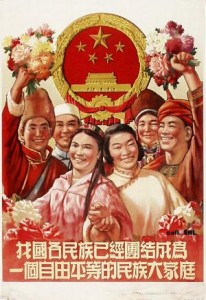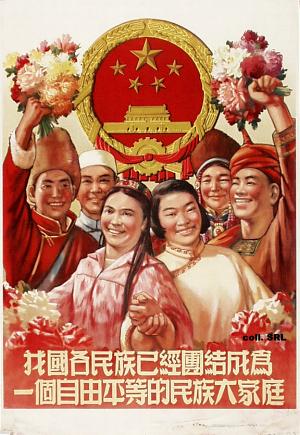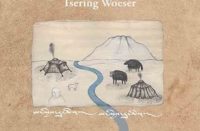High Peaks Pure Earth has translated a blogpost by Woeser originally written for Radio Free Asia on June 30, 2009 and posted on her blog earlier today.
The blogpost, which examines China’s approach to ethnic minority policy, was written after deadly riots broke out in a factory in China’s south between Han Chinese and Uighur workers and before the current unrest in Xinjiang that is attracting international media attention.

All nationalities of our nation have already united
into a great family of independent and equal nationalities
By Woeser
The so-called “three restraints and one leniency” policy was formulated in 1980 as an important part of Hu Yaobang’s ethnic minority policy, which consisted in being “lenient in punishments” to people from ethnic minorities when handling criminals and in applying the principles of “three restraints and one leniency”. The so-called “two restraints and one leniency” policy, according to information gathered, was stipulated in the No. 5 official document issued by the Chinese Central Government in [1984] and the original text stated “when dealing with criminals from ethnic minorities, we have to adhere to the principle of killing less and arresting less, and, as a general rule, we must be lenient in those matters”. These two policies were four years apart, and called “two restraints and one leniency” policy was more practical than “three restraints and one leniency” policy. However, since the origins lay in the first policy, and because his other policies were really daring and his speeches were considered to exceed what is proper, thus, Hu Yaobang was nicknamed Hu Luanbang*.
On the internet a lot of people are protesting the injustice, arguing that the two policies seriously violated the constitution, for according to the constitution, the citizens of the People’s Republic of China are all equal before the law. This sounds quite right. If we change the way we think, what do we base ourselves on when faced with the same crime, ethnic minorities should enjoy special rights when Han people have to endure harsh punishment? Therefore, we can totally understand that Han people took the issue to heart.
But if we take as an example the Tibetan territory of this past half-century, have these two policies been applied over the years? A long time ago, for instance between the ’50s and ’70s, before the special policy was drawn up, the main policy applied to Tibetans was for more punishment against “rioters”, in addition to severe punishment of various kinds of “counter-revolutionaries” as in inland Chinese regions. Countless Tibetans charged with “acts of riotingv were beheaded. According to records of “Extracts gathered from important documents from Tibet Autonomous Region”, in 1980 the Tibet Autonomous Region held a “meeting for the implementation of policies”, and numbers recorded in the meeting are the following: “According to rough statistics, people affected by or involved in rioting are counted in hundreds of thousands, which represent more than 10% of the total population.” These numbers are naturally appalling. But real numbers are much higher than those released during the meetings of the Communist Party.
I have interviewed in the past the leader of a Tibetan rebel group, who is a Han**. As early as 1969, Tibetans were sentenced by court to death by shooting because of a so-called “second riot”. Later, they were found to have been killed by mistake, the miscarriage of justice was redressed and the families received “comfort compensations”. This leader of the Tibetan rebel group said: “Tibetans are too good-natured, when they are about to be shot, they say ‘thanks’; when they are given 200 RMB, they also say ‘thanks’; when they are given 800 RMB, they say ‘thanks’ as well; these Tibetans really are pitiful.” A Tibetan who has experienced the “Red Terror” several times says: “So many bloody incidents have frozen our Tibetans hearts. The so-called ‘disturbances’ of 1987 and 1989 are in fact linked to this hurt.”
What about previous years in Tibetan areas, including the years since the policy was drawn up, has there been anyone who was granted pardon according to the principles of “three restraints and one leniency” or “two restraints and one leniency”? Ngawang Sangdrol, a Buddhist nun, yelled slogans in the Barkhor in 1990 and was consequently arrested when she was only 12 years old; she became the youngest political prisoner and remained 11 years behind bars. In 2005, writer Dolma Kyap was arrested because he wrote a book manuscript commenting on Tibetan history and reality, and he was condemned to a ten and a half year-jail sentence for “agitation and subversion of the country”. Since the age of six, the reincarnation of the tenth Panchen Lama has been imprisoned in a place that is still unknown and has remained there for 14 years already simply because he had been recognized by His Holiness the Dalai Lama. Nonetheless, from last year until today, in the whole Tibetan territory, the huge suffering that Tibetans undergo is known throughout the world, and it is even more a tremendous irony of the policies of “three restraints and one leniency” and “two restraints and one leniency”. It is only that the lies have actually become truth after having been repeated a thousand times, and as a result they have tricked countless Han crowds who do not know the truth. If ethnic minorities are to enjoy their rights, it is essential that these facts be clarified.
June 30, 2009, Beijing
*Note: ‘luan’ (乱) means disorder in Chinese.
** This refers to a rebel group made up of Red Guards during the Cultural Revolution in Tibet.





The special policy you mentioned here is applied in criminal cases, not in political cases. As a tibetan grown up in China, you should know the difference. So why did you confuse the two things in an english article?
ok????????????????????????????????????????
?????????????????????????????????????????????????????????????????????????????????????????????????????????????????????????
?????????????????????????????????????????????,???????????????
The first comment left above by Woeser reads:
Ok! A criminal case! My next article will be using a criminal case to look at non-special policies towards ethnic minorities, thank you very much for reminding me.
Woeser's second comment reads:
I saw a post written by someone on uighurbiz.net that said: Ive read Woesers blog and I have the feeling that this person is a little neurotic and it also seems that she has a rather nebulous mind, if its not for this, then it would simply be confounding right and wrong. For example her English article about the policy of two restraints and one leniency (fewer arrests, fewer death penalties and greater leniency) is utterly misleading those foreigners that dont know the real truth. With regards to this point, her and the CCP methods are in fact very much alike.
The above critic seems to be a little bit mysterious…I should actually thank him for making me write an article using a criminal case to look at non-special policies towards ethnic minorities. After it is broadcast (on Radio Free Asia) I will also post it on my blog.